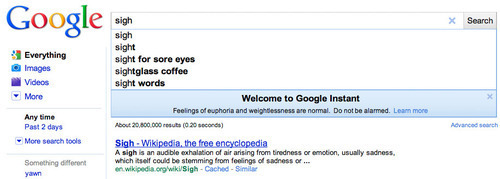
Today Google launched Google Instant, and make no mistake: this is big. It’s far more than just a new fancy interface. It’s a fundamental change to a user interaction model that’s been largely unchallenged for years. It also represents a significant financial and technical commitment on Google’s part (all those new searches and suggestions aren’t free). Last but not least, it clearly demonstrates that Google still has both the means and motivation to challenge a status quo they themselves helped create.
By all accounts this is a bold and brave innovation. Which is why it may surprise you to learn that Google Instant is actually five years old. Yahoo built it back in 2005.
Yes, Yahoo. In 2005.
I can see you’re confused. I don’t blame you. Let’s back up.
Back in 2005, prior to joining the del.icio.us team, I was a product manager on Yahoo’s search team. I led the (truly awesome) team that built and shipped Yahoo’s first AJAX search tools. Our biggest project and crowning achievement was LiveSearch: a fully interactive search UI that produced auto-complete search suggestions and displayed instant search results – in real-time as you typed.
It was slick. It was extremely useful. It was a potential game-changer. And it was almost exactly the same product as Google Instant.
There were differences of course. The search suggestions were displayed on the left side of the results, instead of above them like in Google’s implementation. This was to avoid the distraction of shifting the result set down the screen as the user typed. The relevance of Yahoo’s results at the time were likely lower than what Google is capable of displaying today, but they were still quite good. And the layout clearly needed further optimization, since the default Yahoo SERP at the time was top-heavy with ads and in-network content “shortcuts” (some of which were quite useful, others not so much).
All in all, my assessment is that Google Instant is a superior implementation, but LiveSearch was close. Damn close. It’s something Yahoo should be proud of, and it’s a shame more people don’t know about it.
There is basically no trace left of LiveSearch these days, but here’s an article about it from Google Blogoscoped. And below is a screenshot, taken from the same article:

So what the frak happened? If this innovative product was built nearly 5 years ago (it actually shipped in early 2006), why hasn’t anyone heard of it?
The answer is (mostly) in the screenshot. Yahoo would not let us ship LiveSearch on yahoo.com or as a part of Yahoo’s search engine. Instead we were only allowed to launch it on AllTheWeb, a smaller, lower-traffic search engine that Yahoo had acquired years earlier and largely left to atrophy. (In comparison, Google just launched it on google.com. Boom.)
You have to remember that, at the time, Yahoo’s search business was doing just well enough that there was very little institutional appetite for product risk. As a result, “big” or disruptive ideas were too often left to whither on the vine. By focusing on the local maximum, Yahoo unwittingly traded innovation for incremental optimization.
LiveSearch was thus relegated to a tiny test bucket of users who didn’t actually use Yahoo’s search product (or any modern search engine). Usage data from this flawed test was used to internally evaluate its success in comparison to the model it was actually trying to disrupt. Lacking high-level support for its larger vision and starved for resources, LiveSearch was understandably put out to pasture.
To be fair, this all happened several years ago and user attitudes have changed since then. An interaction paradigm that today seems brilliant was back then perhaps not as immediately accessible to users. I also look back and feel that I could have more effectively “sold” the vision to Yahoo’s management and fought for it. Ah, the benefits of hindsight.
But still, here we are, five years later. And what is essentially the same product is launching to most of the world’s online audience in one fell swoop. Clearly an opportunity was lost somewhere along the way.
While Yahoo’s reputation as an innovator has suffered in recent years, I can tell you first-hand that there was no shortage of amazing ideas inside those walls, some of them way cooler and more disruptive than LiveSearch. Nor was there any shortage of smart, driven, and creative people on the payroll. I worked with a bunch of them.
Instead, what was lacking was the ability to bust past that local maximum. Google may have challenges of its own these days, but today it clearly demonstrated that it still has the organizational courage to challenge its own preconceptions. As I read the coverage and play with Google Instant, I can’t help but wonder how things might have gone if Yahoo had shared this trait five years ago. It could have been pretty damn great.